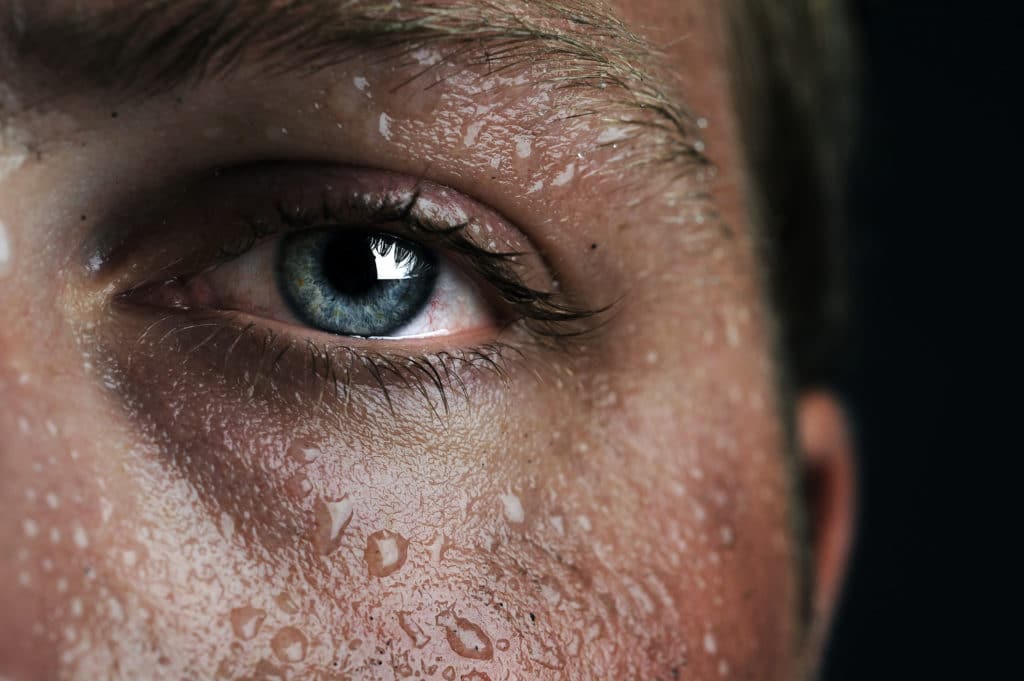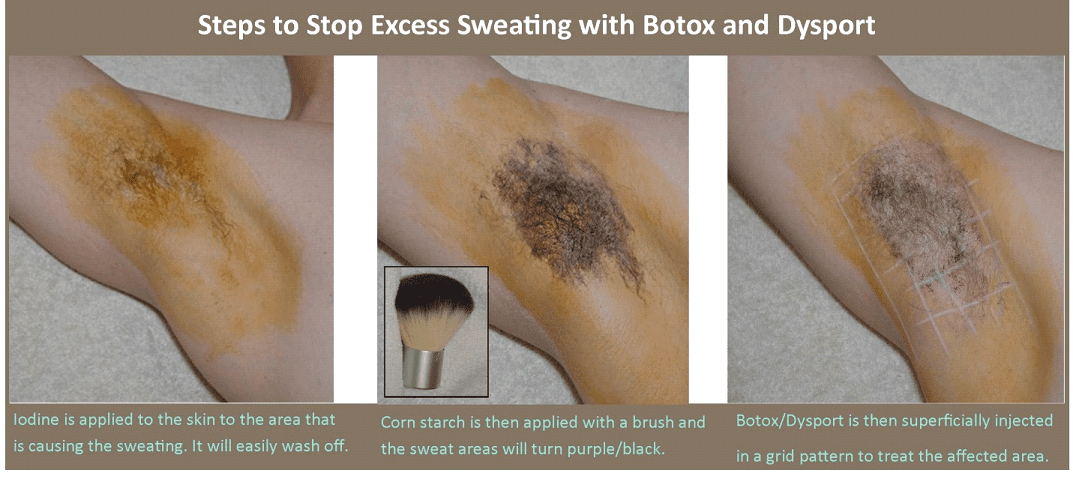COSMETIC DERMATOLOGY AND SKIN CARE FOR Plano, Frisco, and the Dallas Fortworth metroplex in Texas
What is Hyperhidrosis?
Hyperhydrosis is better known as excessive sweating which impacts the lives of one out of every 5 people and can be embarrassing and uncomfortable. For some, however (1 in every 100) hyperhidrosis is socially and professionally debilitating as sweating and body odor can become a problem especially when it is excessive or abnormal. Excessive sweat can be noticeable on clothes, causing discomfort or skin irritation, and can make you feel uncomfortable in public or social situations. It is a disorder rarely talked about because it’s embarrassing. It can also be quite costly if you are constantly looking to replace your wardrobe due to staining.
Sweating is a natural body process that keeps us from overheating and damaging our bodies. However, the glands that regulate and trigger sweating can become overactive, causing some people to suffer from excessive sweating (hyperhidrosis). Typically, hyperhidrosis affects the face, feet, palms of the hands, armpits and trunk of the body. Sufferers usually begin to develop symptoms when young and, without treatment, are forced to deal with the condition throughout their entire lives.
The specific cause of this condition is unknown, but medical research has found that many hyperhidrosis sufferers have unusual sweat glands that cause sweat to secrete at a rate of up to ten times higher than the average person. This has led most physicians to identify overactive sweat glands as the primary cause.
What causes Hyperhidrosis?

When a person has hyperhidrosis, the nerves responsible for signaling your sweat glands become overactive, even though there isn’t the usual trigger of physical activity or a temperature rise. For these people, stress or anxiousness exacerbates the problem. This is known as primary focal hyperhidrosis, and there is no medical cause. There is thought to be a genetic component, as excessive sweating tends to run in families.
Secondary hyperhidrosis occurs when the excessive sweating is the result of a medical condition. These are medical conditions that can cause excessive sweating:
- Diabetes
- Menopause hot flashes
- Thyroid problems
- Low blood sugar
- Some types of cancer
- Heart attacks
- Nervous system disorders
- Infections
Does hyperhidrosis ever become painful?
No. This is not a physically painful condition, but the social discomfort is extreme.
Candidates for Hyperhidrosis treatment
If you suffer from hyperhidrosis, Botox injections could be a great treatment. The one caveat is that patients must be at least 18 years old. Patients should also have already tried topical solutions and found them ineffective.
How does BOTOX® Treat Hyperhidrosis?
BOTOX Cosmetic helps control the symptoms of severe underarm sweating when topical medicines do not work well enough by temporarily blocking the chemical signals from the nerves that stimulate the sweat glands. When the sweat glands don’t receive chemical signals, the severe sweating stops. BOTOX® injections are expected to temporarily stop the production of excessive sweat in the treated areas only. If the sweat glands are rendered dysfunctional, you may be concerned that your body will be unable to perform its temperature regulation function. This is not a concern. The body is easily able to adapt by releasing excess heat from the rest of the surface area of the body. Sweat continues to be produced elsewhere
What BOTOX treatment for Hyperhidrosis is like
Botox when injected superficially into the skin of the armpits, hands, or feet, it can reduce excessive sweating in these areas. It requires a starch-iodine test first, which basically highlights the sweaty areas. The area is swabbed with iodine, and then starch is put on top. The sweaty areas become darker.
Fine needles are used to inject Botox into the sweat glands in the highlighted dark areas. Little pain, if any, is experienced by the patient. The procedure takes only a few minutes and the benefits of the procedure last for approximately six months. Sweating gradually returns after this time.
More than 1% of Americans have this condition which is called hyperhidrosis, and finally there is an extremely effective solution to the problem! Treating the production of excessive sweat has now been made easy by Botox which has been FDA approved for this treatment. Say goodbye to embarrassing moments and feel comfortable in your own skin with Botox.
How Can Botox Benefit You?
- You will no longer have to wear dark clothing all the time
- You can feel confident when raising your hand in class or seminar
- You can enjoy clean, dry clothes that you can comfortably wear throughout the day
- You will look neat and clean by preventing sweat from dampening and displacing your hairstyle or causing makeup to run and smear
- You can shake hands with others without having to worry about sweaty palms
- You will successfully be able to write, draw or play sports without palm sweat interfering with your hand’s grasp
- You can experience the freedom from the body odors that come from clothes and skin that have accumulated dry sweat throughout the day
How effective is Botox for treating hyperhidrosis?
Research has shown Botox to be very effective in treating hyperhidrosis on the underarms and the hands. For underarm sweating, Botox has been shown to result in an 82-87 percent decrease in sweating. For the hands, Botox has decreased sweating up to 90 percent. It is not as effective for sweating on the soles of the feet.
Why Botox is safe for treating hyperhidrosis
The FDA has approved Botox specifically for treating hyperhidrosis. Extensive research into safety and effectiveness led to this approval. Typical side effects are pain and bruising at the injection sites, headaches, and possible flu-like symptoms. These are rare and typically resolve in a day or two.
How many treatments will I need?
Botox does not last forever. Eventually the body’s metabolism breaks down and absorbs the inert Botox. This usually occurs somewhere between 6 and 12 months, although some of our Skin MD patients report effective relief for up to 14 months. On the palms of the hands, Botox stops sweating for about six months.
When the Botox is absorbed, it is time for another injection session to maintain your dryness. This is an ongoing process.
Other Alternatives to Treat Hyperhidrosis
There are a number of treatments for hyperhidrosis;
- Aluminium chloride (topical medication)
- Iontophoresis – regular treatments, placing affected area in electrically charged water/sodium glycopyrrolate
- Medication – suited to those who sweat in several areas
- Anti-wrinkle BOTOX injections – injections used normally for facial wrinkles can be injected in areas such as the underarms/hands/feet. The average duration of effect is 8 months
- Endoscopic thoracic sympathectomy (surgery) – but this can have the effect of compensatory sweating elsewhere after the surgery is performed.
Patient Testimonial
“Having been a client of Dr. Fiona Wright for over 14 years I cannot rave about here artistry in keeping me looking my best! She is concerned about her patients looking natural and I have referred a number of girlfriends to her. They too think she is wonderful! So glad I was guided to her years ago.”
Can Hyperhidrosis go away on its own?
As discussed above, some cases of hyperhidrosis are a side effect of certain medical conditions such as diabetes or thyroid problems. If these medical conditions are resolved and reversed or otherwise brought into control, your excessive sweating will likely diminish.
But if you have primary hyperhidrosis, this is due to overactive sweat glands. This will not go away on its own.
What are some things I can do at home to help with my excessive sweating?
At Skin MD and Beyond, we can help you with your hyperhidrosis with Botox injections. But you can also try some home treatments to help.
At home, you can also employ these strategies:
- Wait between showering and dressing — Allow your body to become cool and dry before you put on your clothes after showering. This is especially true here in Texas with our sticky humidity.
- Shave your armpits — If you’re experiencing heavy underarm sweating, you can try shaving your armpits. Hair holds moisture, and this includes underarm hair. Removing the hair also helps to fight any odor.
- Avoid foods that make you sweat — You may not know this, but your diet can impact how much you sweat. Some foods cause your body to produce more sweat. Low fiber foods make your digestive system work harder to break them down. High-sodium foods make your body detox all that salt in the form of excess urine and sweat. Foods high in fat cause your insides to warm as your body processes the fat.
These foods and drinks can also trigger armpit sweating:
- Processed foods
- Garlic and onions
- High fat foods
- Caffeine
- Hot, spicy dishes
- Ice cream
- Liquor and beer
- Eat more foods that reduce your sweating — Conversely, some foods calm overactive sweat glands and reduce the amount you are sweating. These foods are easy for your digestive system to handle, and they don’t overstimulate your nervous system:
- Foods with high calcium content
- Almonds
- Bananas
- Whey
- Vegetables and fruits with high water content (watermelon, grapes, cantaloupe, broccoli, spinach, cauliflower, bell pepper, eggplant, red cabbage)
- Olive oil
- Oats
- Green tea
- Sweet potatoes
- Stay hydrated — Hydration helps keep your body cool.
- Wear breathable, loose-fitting clothing — Eliminate clothes that fit snugly under your arms. Wear breathable fabrics and clothes that fit more loosely. This is especially smart in toasty Plano, Texas.
- Lose the caffeine — Caffeine stimulates the nervous system and increases sweating. It also causes your blood pressure to rise, raises your heart rate, and kicks your sweat glands into action.
- Stop smoking — Nicotine works like caffeine, raising your body temperature, heart rate, and sweat production.
Is there any recovery after having Botox injections for hyperhidrosis?
There isn’t any recovery. These treatments at Skin MD only take a few minutes. Afterwards you can head back to work or get back to your normal activities immediately.


